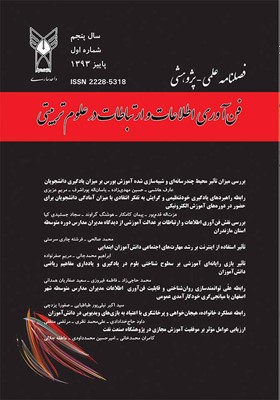بررسی نقش فن آوری اطلاعات و ارتباطات بر عدالت آموزشی از دیدگاه مدیران مدارس دوره متوسطه استان مازندران
محورهای موضوعی : فن‎آوری اطلاعات
محمد صالحی
1
![]() ,
فرشته چاری سرستی
2
*
,
فرشته چاری سرستی
2
*
1 - دانشیار گروه علوم تربیتی، دانشگاه آزاد اسلامی واحد ساری، ساری، ایران
2 - کارشناس ارشد مدیریت آموزشی، دانشگاه آزاد اسلامی واحد ساری، ساری، ایران
کلید واژه: فن آوری اطلاعات و ارتباطات, عدالت آموزشی, یادگیری فردی, یادگیری محیطی,
چکیده مقاله :
این پژوهش، با هدف بررسی نقش فنآوری اطلاعات و ارتباطات بر عدالت آموزشی از دیدگاه مدیران مدارس دوره متوسطه استان مازندران انجام شد. روش پژوهش توصیفی، از نوع زمینهیابی بود. جامعه آماری، شامل کلیه مدیران مدارس متوسطه استان مازندران میباشد. حجم نمونه با استفاده از جدول کرجسی و مورگان 238 نفر تعیین شد. روش نمونهگیری تصادفی طبقه ای بر حسب جنسیت بود و بدین ترتیب، 149 نفر زن و 89 نفر مرد به عنوان نمونه انتخاب شدند. ابزار جمعآوری اطلاعات، شامل پرسشنامه 40 سؤالی است که نقش فنآوری اطلاعات و ارتباطات بر عدالت آموزشی را در چهار بعد توسعه گسترده دسترسی، انعطافپذیری یادگیری فردی، انعطافپذیری یادگیری محیطی و ارایه بازخورد مورد بررسی قرار میدهد. روایی محتوایی پرسشنامه از نظر متخصصان تأیید شد و پایایی آن با استفاده از آزمون آلفای کرونباخ، 0/82 محاسبه شد. داده های جمعآوری شده با استفاده از آزمون تی تکنمونهای مورد بررسی قرار گرفت. نتایج نشان داد که فنآوری اطلاعات و ارتباطات از طریق توسعه گسترده دسترسی، انعطافپذیری کردن یادگیری فردی، انعطافپذیری کردن یادگیری محیطی و ارایه بازخورد فوری بر عدالت آموزشی نقش داشته است.
This research was conducted aiming to study the ICT role on educational justice from the view point of secondary school managers in Mazandaran province. The research method was descriptive survey. Statistical population was all secondary school managers of Mazandaran province. Based on Krejcie and Morgan, sample size determined 238 individuals (149 female and 89 male), who were selected through stratified random sampling method. Information gathering tool was educational justice questionnaire with 40 questions which were answered by the managers. The questionnaire involved the effect of information and communication technology on educational justice in four dimensions: availability broad development, individual learning flexibility, environmental learning flexibility and feedback presentation. Content validity of the questionnaire was confirmed by specialists’ perspective, and the reliability, using Chronbach's Alpha Coefficient, was calculated 0.82. The collected data was analyzed using one sample t test. The research results showed that ICT was influential on educational justice via availability broad development, individual learning flexibility, environmental learning flexibility and immediate feedback presentation.

